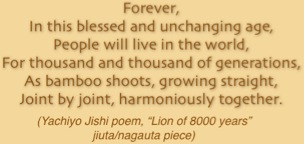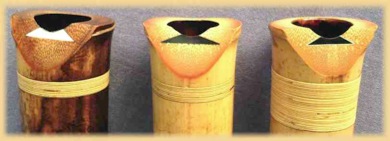............................



Imported by China from the 8th century, the shakuhachi has a very long history which brought it beyond its own musical and geographical borders, attracting the interest of numerous composers, musicians or music lovers of various horizons, and giving rise to several communities, worldwide, enthusiastic and very active at present time.
This instrument attracts and fascinates by its rich tone, providing several colors, by its intense relation with the breath, by the serenity and the depth coming from its ancestral music, and its adaptability to various styles.
Aa a rather simple massive vertical flute, the shakuhachi is made out of a root of Madake bamboo, cut with 7 nodes. The standard size of 1 foot (shaku) and 8 (hachi) inches (54,5 cm) gave its name to all the flute family. Of increasing conical shape outside, the inside oppositely has a decreasing shape with a diameter of about 2 cm at the top of the tube . This very wide opening mouthpiece, compared with that of the other types of flutes, brings a special relationship to the air column and its volume, as well as the development of a unique embouchure technique implying unusual head movements. This brings to the possibility of obtaining any possible pitch, basically restricted by the only 5 existing holes, as well as to a whole set of specific playing techniques.
ISSOKU-ON....one sound in one breath...
SASA-BUKI....blowing a bamboo leave...
MAWASHI-YURI....waved sound...
KOMI-BUKI....panting breath...
The traditional music, native from the Edo period (around 1600-1868) during which this instrument had its major development, arised from the practice of a sect of itinerant Zen monks from the Rinzai branch (komuso or monks "from emptiness and nothingness"), coming with a legendary and chaotic history. The monks had the unique privilege to possess this instrument and to use it as an awakening tool (suizen, " blowing Zen "), sharing their time between military and spiritual practices, travelling and begging through the whole country.
The fundamental music honkyoku arisen from this lifestyle constitutes of numerous pieces, mainly solo, built on the rhythm of breath more than on a regular rhythmical bit, giving birth to various schools afterwards between the 18th and the 20th century. These pieces can be divided into various categories (pieces for daily services, descriptive pieces, pieces connected with nature, meditative pieces, etc.) but they can be the object of a double reading: beyond their suggestive titles, they show a certain philosophy of life and deep human feelings.
The shakuhachi has belonged to none of the orchestral or theatrical forms during this long period, then it went out of its isolation and its religious context by opening itself to all the musical existing genres: at first by joining the urban music at the end of the 19th century, then developping from the popular to the contemporary music including jazz, rock, and diverse experimental genres.
MURA-IKI....throw the breath...
MA....hold...
FUKI-KIRI....cut the breath...

...ARTICLE in French: "Le shakuhachi, hier et aujourd'hui" (shakuhachi, yesterday and today),
...published by the revue of the French flute association, "Traversières Magazine",
...written by Véronique Piron,
...10 pages with pictures, 2005.